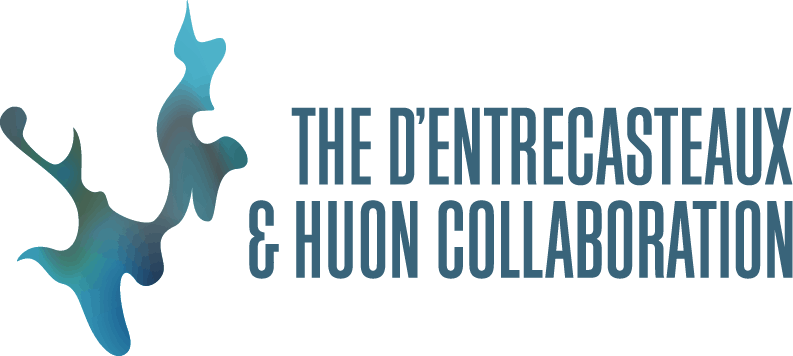The coastline of the D’Entrecasteaux Channel and lower Huon estuary hosts many small, hidden and sheltered beaches. These are popular recreation sites for activities that include walking, swimming, kayaking, sailing and fishing.
BEACHES AND SWIMMING
Every summer, Kingborough Council monitors urban beaches at Tinderbox, Sung, Coningham, Alonnah and Nebraska for enterococci, which is the preferred recreational water quality measure. Water quality conditions for swimming sites in the waterway have traditionally been excellent and there have been no closures of recreational beaches due to water quality. However, as a rule analysis results are likely to be higher after rainfall and it’s recommended that beach-goers avoid swimming at urban beaches for a few days after heavy rainfall.
BEACHES AND DOG-WALKING
Dog walking is a popular activity on many of the beaches in the D’Entrecasteaux and Huon region. Please note that not all beaches are open to dogs, some have restricted access (off-limits during shorebird breeding season), some are on-lead beaches only while only a few are year-round off-lead beaches. Please take the time to familiarise yourself with any restrictions before taking your furry companion to the beach, ensure that they don’t approach wildlife, and clean up after your dog.
POPULAR BEACHES
Some popular beaches and the facilities available:
West shoreline of the waterway (North to South)
Tinderbox Beach* (toilets, playground, bbq)
Peggys Beach
Snug Beach (toilets)
Coningham Beach (toilets)
Trial Bay (toilets, swings, bbq)
Middleton Beach (toilets, playground)
Nine Point Marine Reserve (note: this a popular dive site, NOT a beach!)
Verona Sands (toilets)
Randalls Bay (toilets)
Eggs & Bacon Bay (toilets)
Esperance Beach
Roaring Beach
Kent Beach, Dover
Bruny Island shoreline of the waterway (South to North)
Jetty Beach (toilets, Tas Parks and Wildlife Service campground)
Curlew Beach
Sheepwash Bay
Alonnah Beach
Nebraska Beach
BOATING
The waterway is regarded as a world-class area for boating and fishing, and is a popular destination.
Check in with Marine and Safety Tasmania for information about mooring, boat waste, and what general marine safety practices and guidelines apply. The D’Entrecasteaux Channel and lower Huon estuary caters for a wide range of boating activities from commercial ferries and large yachts to kayaks, dingys and sailing regattas.
Boating clubs include:
Kettering Yacht Club, Cygnet Yacht Club, Bruny Boat Club and the Huon Yacht Club
FISHING
Anecdotal evidence suggests that the fishing opportunities in the waterway have changed significantly over the decades. If you are fishing in the waterway, please help maintain viable fish stock by adhering to the guide for recreational fishing.
The Collaboration is promoting registration of species rarely caught in the waterway with Redmap. Redmap is a Tasmanian initiative that uses community registration of unusual species to track the redistribution of marine species. Through Redmap, fishers can build hard data that helps understand if and how oceanic currents are affecting our waterway.
This is a handy reference if you are new to fishing in the D’Entrecasteaux Channel and want to know what to expect and if this is the sport for you then it is certainly worth hooking up with the Tasmanian Association for Recreational Fishing.
HARVESTING
The Shellfish Market Access Program (ShellMAP) is a collaboration between State Government and the shellfish industry. Public alerts are issued during periods of biotoxin risk to warn against the consumption of wild shellfish in affected areas. Pathogens associated with sewage inputs are also monitored by ShellMAP.
A permanent health advisory issued by the State Department of Health and Human Services (DHHS) recommends that recreationally harvested wild bivalve shellfish not be eaten, since poor water quality in unmonitored areas could cause contamination of shellfish, particularly during heavy rainfall or algal blooms. Signs warning of the dangers of consuming wild shellfish have been installed at 12 sites in the Channel and 11 sites in the Huon Estuary/Port Esperance. It is safe to eat bivalve shellfish from approved retail outlets because of the ShellMAP monitoring. Further information on periodic and permanent public health shellfish alerts can be obtained at: https://www.dhhs.tas.gov.au/publichealth/alerts
The Public Health Hotline can also be contacted on 1800 671 738.
Finfish do not accumulate biotoxins. Food safety of farmed salmon is ensured through regular sampling and quality testing as part of the Food Safety, Australia and New Zealand (FSANZ) Australian and New Zealand Food Standards Code which is regulated under Commonwealth Law. Heavy metals are considered a minor risk to seafood in the D’Entrecasteaux Channel and lower Huon Estuary, and monitoring has revealed concentrations that are consistently below maximum permitted levels (MLs).

